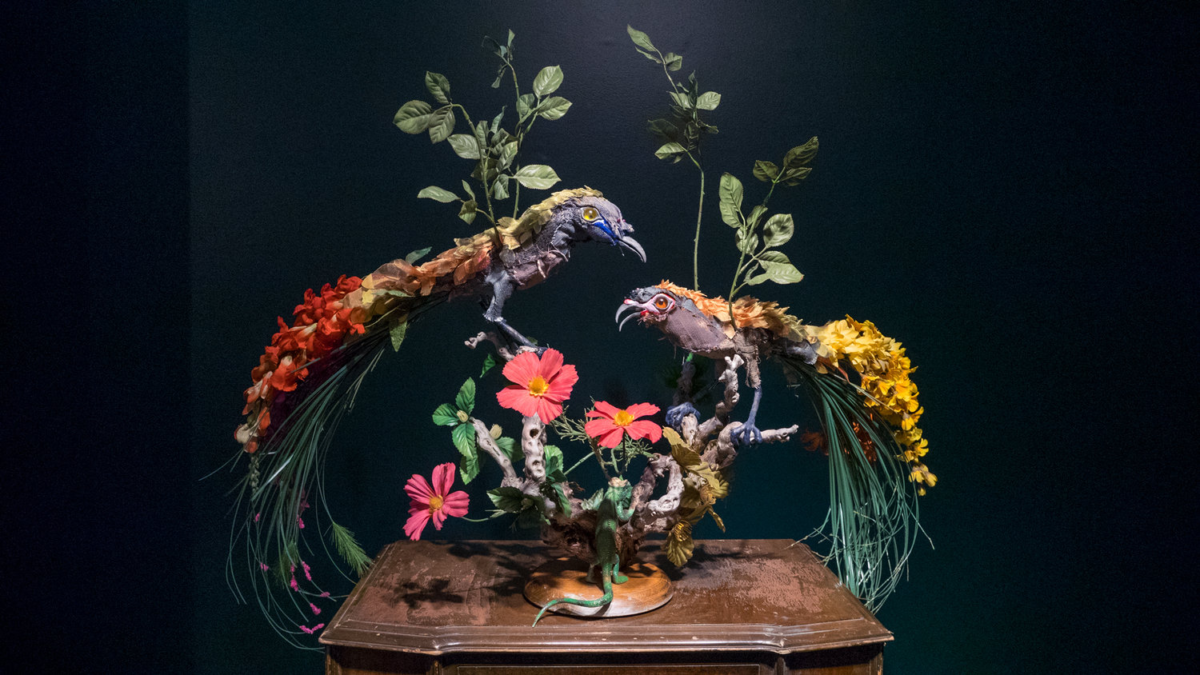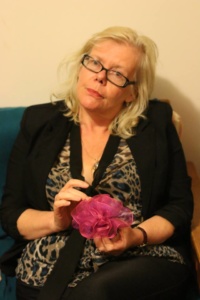Where Art and Science Meet: Emily Jan

Two little girls stand transfixed before a mixed-media sculpture by Emily Jan, which takes the life-sized shape of a fabulous anteater. Its intense pink, shiny tongue is frozen in a gesture that snakes towards the girls and then ends with a flourish of greenery. A large bouquet of vividly coloured flowers cascades from its hindquarters and contrasts with the creature’s soft, snowy coat. The girls are puzzling this out. It doesn’t resemble any creature they’ve encountered in reality. It is literally fabulous or fable-like; Jan calls this series of sculptures Apologues, as in the animal populated stories of Aesop, although these are simply numbered rather than titled. Jan’s sensibility may be literary but she is never literal. The girls want to know, “what is the fable about?” They speculate about familiar squirrels and birds, “creatures that eat seeds and then poo them out” starting a new crop of plants. Their conclusion: “it’s the cycle of life, just like in The Lion King.”
The earnest young art critics have successfully untangled the challenge of interconnectivity in Emily Jan’s exhibition, The World is Bound by Secret Knots. Or perhaps they have enacted one of Jan’s favourite concepts, “the artist as explorer.” They have journeyed to the safe jungle of the artist-run gallery, explored, discovered and studied. This ambitious solo show of ten vignettes in fibre and mixed media is Emily Jan’s response to a three-week residency in the Peruvian Amazon. This 2015 rainforest adventure was typical of Jan’s creative practice, which alternates between research travel and exploration–she has been to 36 countries so far–and long periods of deep engagement with materials and process in the studio. She needle felts raw wool into fur for her hybrid beings, casts resin for their skulls, teeth and impressive claws and hand weaves caning into armature-like skeletons. Second hand flowers and foliage are up cycled into fantastic accents that evoke forests and domestic decoration.
Characteristically, Emily Jan avoids plinth furniture that is common to art galleries. Her methods of display are nuanced selections from the domestic arena: tables, desks, plant stands and shelves. These in turn are harvested from the sustainable economies of the thrift shop or are temporary loans from the community of the exhibiting venue. Think of it as an artistic variation of “catch and release” hunting.
The furniture choices for The World is Bound by Secret Knots extend the aesthetic and narrative possibilities of her sculpture. Tables that would otherwise nest, are stacked vertically becoming small scale towers of consumption. They perch upon each other with neat, poised feet. Curved furniture lines resonate with curling talons, beaks and snake coils. Furniture references function and the warmth of the human hand. The rainforest has come into this living space although not through the use of precious exotic woods. There is a palpable animated energy in the room. A diamond-patterned textile leg from a pair of tights becomes a sinuous serpent on an equally sinuous branch that sprouts a surprising pair of eyes. Will we get consumed by our own habits of consumerism?
Emily Jan blurs the distinctions of time and being in her sculpture. It is hard to tell if her creatures are flourishing or becoming extinct; are they regenerating or are they in a state of decay? Fungus, plant and animal merge in ways that erode the boundaries of species. A fierce bird of prey is festooned with strands of beads that resemble both entrails and caviar. Jan confounds our categories of understanding into a fertile hybridity of fact and fiction. A rich ambiguity seems to have replaced the laws of nature.
Although the series is called Apologues, Emily Jan does not moralize. Instead she seduces the viewer with voluptuous form, detail and colour that is ultimately mysterious. Beauty resides in both the flowers and the weeds. The domains of science and art, which are both ways of understanding the world, are brought together to enhance each other. If fallacy is allowed in art, it is simply because it is another kind of truth.
Gloria Hickey

Gloria Hickey is an independent writer and curator based in St. John’s, NL. She has published more than 300 articles and has won the Critical Eye Award (VANL), Betty Park Award for Critical Writing (CA), and the award for Industry Leader in Atlantic Canada. She has an M.A. in Philosophy from the University of Toronto. Her most recent book chapter was published by Routledge, U.K.